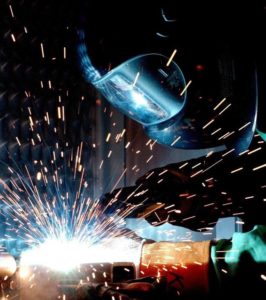How do Welders use Soapstone?
 Sorry but, soapstone is not made from soap. Soapstone is primarily made from a soft clay mineral called talc, which is composed of hydrated magnesium silicate. Talc is so soft that it is gentle enough to be used in baby powder. There are also other minerals found in soapstone as well, e.g., chlorite, carbonites, micas. The higher the talc content the softer the soapstone, it is the material with this high (as high as 80%) that is perfect for the high temperature marking needed in welding and torch cutting applications.
Sorry but, soapstone is not made from soap. Soapstone is primarily made from a soft clay mineral called talc, which is composed of hydrated magnesium silicate. Talc is so soft that it is gentle enough to be used in baby powder. There are also other minerals found in soapstone as well, e.g., chlorite, carbonites, micas. The higher the talc content the softer the soapstone, it is the material with this high (as high as 80%) that is perfect for the high temperature marking needed in welding and torch cutting applications.
When you are welding or fitting up a weldment, you need to be able to make marks on the material, much in the same way a carpenter would use a pencil or chalk line. However, you cannot make very clear marks with a pencil on steel. In this case, it is better to use a piece of soapstone since it is more visible. Soapstone in welding is used in nearly every phase of fabrication. Of course, other methods (e.g., paint pen) can be used for some of these phases. When it is used, it is often used with a soapstone holder. There are both round and flat versions, depending on the shape of your soapstone. Of course, you can freehand it without a holder. But the advantage of a holder is that you are less likely to break your soapstone, especially if it is thinner. If you do break it, it will probably only break off at the tip. Even before the steel gets to the fitter to be assembled for the welders, it often already has markings on it from the supplier. Suppliers get the set of project drawings which includes a cut list and the supplier will then designate on each piece of material the part number. This is usually done with a paint pen or tags, but it can be soapstone as well. When the metal arrives from the supplier it is the fitter’s job to assemble pieces per a given drawing with spot or tack welding. Soapstone is necessary for this stage of fabrication. Before the fitter can put the pieces of metal in the right place, he needs to do some layout. Through a careful reading of the drawings, he will use the soapstone to inscribe the edges of each piece of material. One of the benefits of soapstone being soft is that you can file or sand it down to the desired thickness to make your marks. If you have a tight tolerance, you can make the soapstone thinner to be more precise.
Another use for soapstone markers in welding fabrication is for flame straightening. When a welded joint gets distorted from the torsional stress of too much heating, an oxy-acetylene torch can be used to heat the material to counteract the stress on the opposite side of the joint. In this case, the dimensions of the weld path (no more than half an inch on either side of the weld toes), are transposed to the other side of the joint and traced out using soapstone. This is the ideal method of marking the material since the soapstone marks will not fade or be blown away by the heat generated by the torch.
Sometimes you need a sharp edge on your soapstone marker. If you have flat soapstone, use 300 grit sandpaper to work it down in one spot until you like the result. You can also use a metal file or grinding wheel. For round markers, you can use a regular crank style pencil sharpener, though some people have been known to use a belt sander or even a grinder. A good source of flat soapstone, sometimes called kale, refill markers for soapstone pencils is Tech Team’s #757 pack of 36 pieces https://techteamproducts.com/product/soap-stone-refills-00757/ https://www.amazon.com/dp/B07JMFBFW3?ref=myi_title_dp they are machines to the correct size and sourced from talc that is the correct softness. You can do a hey Siri or hey Alexa Google search or view the video https://youtu.be/NnClGrkxZ7I on you tube.
In general, welders and fabricators would have a tough time doing away with soapstone as it makes seeing their measurements relatively easy. Though it cannot replace the precision of a chalk line or machined notches in a surface, these would not be possible without laying down the initial marks with a soapstone mark.
